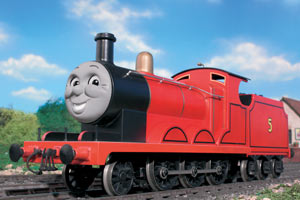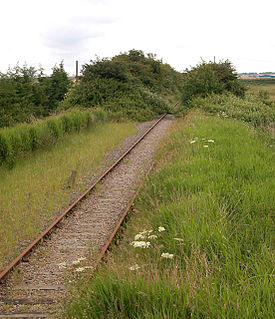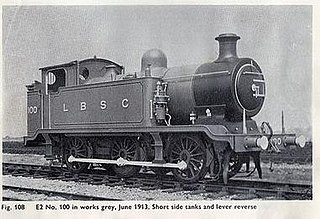
Wilbert Vere Awdry was an English Anglican minister, railway enthusiast, and children's author. He was best known for creating Thomas the Tank Engine. Thomas and several other characters he created appeared in his Railway Series.

The Fat Controller, whose real name is Sir Topham Hatt, is a fictional character in The Railway Series books written by the Reverend W. Awdry and his son, Christopher Awdry. In the first two books in the series he is known as The Fat Director, and as of the third book he becomes The Fat Controller, as the railway has been nationalised. Sir Topham Hatt's full name is revealed in the foreword to the 1951 book Henry the Green Engine.

James is a fictional anthropomorphic red tender locomotive from The Railway Series children's books by the Reverend Awdry and the TV series adaptation Thomas & Friends. He is a mixed-traffic engine, which means he is just as capable of pulling coaches as trucks. He has a 2-6-0 ("Mogul") wheel arrangement and is engine number 5 on the North Western Railway, The Fat Controller's railway on the Island of Sodor.

Toby is a fictional anthropomorphic brown square tram engine in The Railway Series by the Reverend Wilbert Vere Awdry and his son, Christopher; he also appears in the television series adaptation Thomas & Friends. Toby, a tram engine with cowcatchers and sideplates, carries the North Western Railway running number seven and works on the same Ffarquhar Branch Line as Thomas the Tank Engine.

The Bramley Line is a railway line between March and Wisbech in Cambridgeshire, England. A number of proposals are currently being investigated relating to the possible restoration of passenger services along the route.

The London, Brighton and South Coast Railway (LB&SCR) E2 Class was a class of 0-6-0T steam locomotives designed by Lawson Billinton, intended for shunting and short distance freight trains. Ten examples were built between 1913 and 1916, and were withdrawn from service and scrapped between 1961 and 1963.

The GER Class C53 was a class of twelve 0-6-0T steam tram locomotives designed by James Holden for the Great Eastern Railway. They passed to the London and North Eastern Railway at the grouping, and received the LNER classification J70.

The GER Class G15 was a class of ten 0-4-0T steam tram locomotives designed by Thomas William Worsdell for the Great Eastern Railway. They passed to the London and North Eastern Railway (LNER) at the 1923 grouping, and received the LNER classification Y6.

The Wisbech and Upwell Tramway was a rural standard gauge tramway in East Anglia. It was built by the Great Eastern Railway between Wisbech, Isle of Ely, Cambridgeshire and Upwell, now in Norfolk to carry agricultural produce. Although called a tramway, in many ways it more closely resembled a conventional railway line, and paved the way for the passing of the Light Railways Act 1896.

The LNER Class Y10 was a class of two 0-4-0T geared steam locomotives built by Sentinel Waggon Works for the London and North Eastern Railway and introduced in 1930. The LNER numbered them 8403 and 8404 but they were later re-numbered 8186 and 8187. This was the second use of the classification Y10 by the LNER. The first was for an ex-North British Railway 0-4-0 steam tender locomotive, withdrawn 1925.

A tram engine is a steam locomotive specially built, or modified, to run on a street, or roadside, tramway track.

Nottingham Arkwright Street was a railway station in Nottingham on the former Great Central Main Line which ran from Manchester Piccadilly to London Marylebone. The station opened with the line in 1899 and closed in 1963 as part of rationalisation; it reopened four years later upon the closure of Nottingham Victoria railway station, only to close in 1969.

Wisbech East was a railway station in Wisbech, Cambridgeshire. It was opened in 1848 and became part of the Great Eastern Railway network, providing connections to March, Watlington and St Ives, as well as Upwell via the Wisbech and Upwell Tramway. The station closed in 1968 and no trace of it remains today. A freight-only line remains extant as far as a factory based in the station's former goods yard, and a heritage railway based in March is aiming to reinstate services to Wisbech and construct a new station as near as possible to Newbridge Lane crossing.

Elmbridge railway station was a stop on the Wisbech and Upwell Tramway. It was in a projection of the parish of Emneth, Norfolk but was immediately south-east of the town of Wisbech, Cambridgeshire. It was opened on 20 August 1883 to serve nearby settlements and closed to passengers on 2 January 1928. The tramway ceased by closing to goods in 1966.
Boyces Bridge railway station was a station in Norfolk on the Wisbech and Upwell Tramway commonly known as the Upwell Tramway. It was located north of Outwell. It was opened in 1883 along with the rest of the line, and closed to passengers in 1928 and goods in 1966.
Outwell Village railway station was a station in Outwell, Norfolk on the Wisbech and Upwell Tramway. It opened in 1884 and closed to passengers in 1928. Goods services ran on a while longer, before finishing in 1966. The line provided inspiration for Toby the Tram Engine.
Outwell Basin railway station was a stop on the Wisbech and Upwell Tramway in Outwell, Norfolk. It opened in 1883 carrying passenger and goods traffic from nearby farms. It was closed to passengers in 1928, with goods services continuing on the line until 1966. The line it once stood on is now a grassy track.

Olney was a railway station on the former Bedford to Northampton Line and Stratford-upon-Avon and Midland Junction Railway which served the town of Olney in Buckinghamshire, England. It was situated on a busy section of line between Towcester and Ravenstone Wood junction which saw heavy use by freight services running between Wales and north-east England. The station closed for passengers in 1962 and completely in 1964, the various connecting routes to the line having closed one by one from the 1950s onwards.













